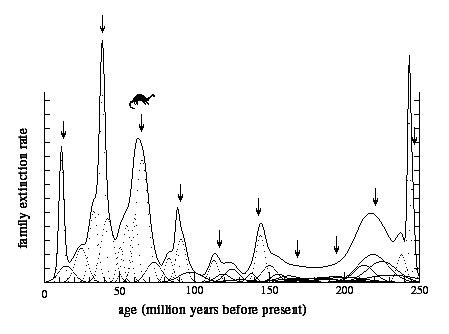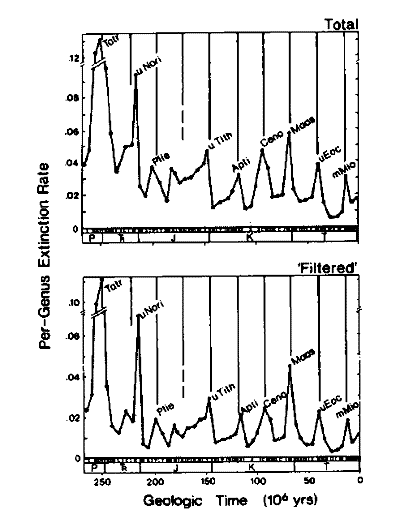|

by Richard Muller
from
Muller'sGroup Website
Origin of the theory
The "Nemesis Theory" was an outgrowth of the discovery of
Alvarez et
al., that the impact of a large (>10 km diameter) comet or asteroid
was responsible for the great mass extinction that took place 65
million years ago.
Studies of the fossil record by Dave Raup and Jack Sepkoski shows
that this was not an isolated event, but one of several mass
extinctions that appear to occur on a regular 26 million year cycle.
Their original paper analyzed marine fossil families, and was
published in the Proceedings of the National Academy of Science USA, vol 81, pages 801-805 (1984).
The original extinction data of Raup and Sepkoski are replotted in
the following figure.

The vertical axis shows the "extinction
rate." This was taken from the values given by Raup and Sepkoski for
the percent family extinctions at each geologic boundary. In order
to take into account the uncertainty in the boundary ages, each data
point was plotted as a Gaussian, with width equal to the
uncertainty, and area equal to the extinction rate. This plot thus
represents a statistical estimate of the extinction rate vs. time.
The individual Gaussians for each stage boundary are shown as dotted
lines. The extinction 65 million years ago is indicated with the
little dinosaur icon.
The peak near 11 Ma is real, but exaggerated by the requirement that
the plot go to zero at the present. Arrows are plotted every 26
million years. Note that many of these are close to the peaks in the
extinction rate. This is the apparent 26 million year periodicity
discovered by Raup and Sepkoski.
There have been many statistical studies of these data. Although
several studies indicate the periodicity is significant, not
everyone agrees. I suggest that you decide for yourself. If you
decide that the extinctions are not statistically significant, then
there is no need for the Nemesis theory.
Additional work by Sepkoski shows that the periodicity is also
present for fossil genera. His results were published in the Journal
of the Geological Society of London, vol 146, pp 7-19 (1989). Figure
2 from this paper is shown below. Please note that the time axis has
been reversed compared to that of the previous figure.

Plotted is the per-genus extinction rate
(in units of extinctions/genus/Myr) for 49 sampling intervals. The
upper time series (labeled Total) is for Sepkoski's entire data set
of 17,500 genera, whereas the lower "filtered" time series is for a
subset of 11,000 from which genera confined to single stratigraphic
intervals have been excluded. The vertical lines are plotted at 26
Myr intervals.
The Nemesis theory was devised to account for this regularity in the
timing of the mass extinctions reported by Raup and Sepkoski.
According to this model, a companion star orbiting the Sun perturbs
the Oort comet cloud every 26 Myr causing comet showers in the inner
solar system. One or more of these comets strike the Earth causing a
mass extinction. The Nemesis theory was originally published in
Nature by Davis, Hut, and Muller (vol 308, pp 715-717, 1984). A
longer description of the work leading up to the theory was written
in book form: "Nemesis," by Richard Muller (Weidenfeld & Nicolson,
1988). See Chapter 1 -
Cosmic Terrorist.
Stability of
the Nemesis orbit
There is a great deal of confusion among astronomers about the
stability of the Nemesis orbit. Even many theorists who should know
better believe that the orbit is unstable, and that the original
Nemesis paper was in error. However detailed calculations by Piet
Hut at the Institute for Advanced Study in Princeton show that the
original estimate about the orbit were correct. Hut's results were
published in Nature, vol 311, pp. 636-640 (1984). In our original
paper we had stated that the orbit presently has a stability time
constant of approximately one billion years.
Many people naively assumed that this
was incompatible with the 4.5 billion-year age of the solar system.
But unlike the lifetime of a radioactive element, the lifetime of
the Nemesis orbit is not predicted to be constant with time. In
fact, Hut has shown that the lifetime decreases linearly, not
exponentially, with age. The expected orbit lifetime when the solar
system was formed was (presumably) about 5.5 billion years. When
nearby stars pass the solar system, the orbit of Nemesis is given
slight boosts in energy. The Nemesis orbit becomes larger and less
stable. At present, the Nemesis orbit has a semi-major axis of about
1.5 light-years, and the orbit is expected to remain bound to the
sun for only another billion years.
Note that the Nemesis theory predicts that the periodicity should
not be precise. Perturbations from passing stars are not sufficient
to disrupt the orbit, but they are sufficient to cause a slight (a
few Myr) jitter in the interval between extinctions.
Why do so many people think the orbit is unstable? The basic answer
is that scientists often don't have time to read the literature, so
they depend on the summaries of others. For more details, see below
insert:
|
Nemesis for Nemesis?
The issue of the
theoretical stability of the Nemesis orbit has been
settled, but most astronomers don't know the answer.
Actually, they think they know the answer, but they are
incorrect. As the 19th century humorist Josh Billings
said, "The trouble with most folks isn't so much their
ignorance. It's know'n so many things that ain't so." I
can guide you to the origin of the confusion.
Look at Nature Vol 311, Oct 18, 1984. You will find a
host of articles on the stability of the Nemesis orbit.
In addition, you will find an editorial comment by Mark
Bailey (on page 602), entitled "Nemesis for Nemesis."
The articles are as follows:
1. J. G. Hills (page
636) analyzes the stability of the Nemesis orbit. He
supports the Nemesis hypothesis and calculates some
details. He speculates that Nemesis may be
responsible for the eccentric orbit of Pluto. (Hills
was the theorist who originally recognized the
possibility of comet showers.)
2. Piet Hut (page 638) does the most complete and
definitive analysis of the Nemesis orbit. He
concludes that the results given in the original
Nemesis paper are verified: the orbit has a
stability time constant of about one billion (10^9)
years. This means that the remaining life of the
orbit is a billion years. When the solar system was
created 4.5 billion years ago, the Nemesis lifetime
would have been about 5.5 billion years, and we have
used up 4.5 of those. The 10^9 year stability
implies that the present orbit is not perfectly
periodic, and this is verified by a careful
examination of the extinction data. Hut shows that
the Nemesis orbit is stable only if it is near the
plane of the Milky Way. (Hut is now a fellow at the
Institute for Advanced Study at Princeton.)
3. Torbett and Smoluchowski (page 641) conclude that
passing giant molecular clouds would make the
Nemesis orbit unstable. However they neglect the
fact that these massive clouds are very diffuse;
later work (D. Morris and R. Muller, Icarus v. 65,
p. 1-12) show that these clouds actually have no
effect on the orbit stability.
4. Mark Bailey wrote an editorial review (page 602)
entitled "Nemesis for Nemesis," in which he says,
"the Nemesis proposal is extended and shown, in
fact, to be quite incapable of producing the
strictly periodic sequence for which is was
originally designed." This is a misinterpretation of
the original Nemesis paper (Nature vol 308 pp
715-717, 1984). We never expected a perfectly
periodic signal in an orbit that had only a 10^9
year lifetime. Bailey goes on to characterize Hut's
paper as "a near retraction"!!!! Hut considered his
paper to be a vindication of the original Nemesis
paper. He contacted Bailey to find out how Bailey
could be so wrong in his understanding, and Bailey
told Hut that he never wrote those words! "Near
retraction" had been inserted by the editor at
Nature!
Bailey also refers to a
paper by Clube and Napier, in which they show that the
Nemesis orbit has a stability of 10^9 years. But Clube
and Napier then conclude that this rules out the Nemesis
theory, rather than realizing that this stability is
exactly what we had said in our original paper.
Apparently they never realized (as did Hut) that the
expected lifetime of Nemesis is linear, not exponential,
so that that the present stability is not the same as
the stability 4.5 billion years ago.
But now for the fascinating sociology of science. I have
talked to many astronomers since 1984, and the majority
of them believe that the Nemesis theory was ruled out,
because the orbit turned out to be unstable. In most of
these cases I could track down the origin of their
opinion. Frequently the opinion had been obtained from
someone else -- often the local planetary scientist. But
in every case, the ultimate origin was the altered
article by Mark Bailey in Nature.
Why is this? Because Bailey summarized the three
articles -- there was no need for a busy scientist to
read the actual papers. I never found an expert (i.e.
someone that others depended on for their opinion) that
had actually read the Hut article. Why bother, when it
amounts to a "virtual retraction"?
The trouble with most folks, isn't so much their
ignorance ....
At the time, Piet and I thought we would find Nemesis
soon, so he decided not to write a letter to the editor
complaining about the error in the Bailey summary.
That's half the story of why Nemesis is not believed.
The other half is that we predicted we would find it
within a few years, and we haven't. So most people think
our search found no such star. In fact, the search
stalled soon after it started. There is no reason to
believe that Nemesis is not the solution to the mystery
of the periodic extinctions, and there is no alternative
theory that has survived scrutiny. |
The Search for
Nemesis
Nemesis is most likely a red dwarf star, magnitude between 7 and 12.
Virtually all such stars have been catalogued, but very few of them
have had their distance measured. It is likely that Nemesis, if it
exists, will be visible with binoculars or a small telescope.
We don't need a large telescope to find Nemesis. We need a small or
medium telescope, and enough time to look at and analyze 3000
candidate stars. A series of images taken throughout the year should
allow us to measure the large parallax of this star. We are also
eliminating the stars measured by the Hipparcos satellite.
We began the search for Nemesis using the automated telescope at
Leuschner Observatory. However this telescope was not designed for
the heavy use it was receiving from this search and from our
automated search for nearby supernova.
Fortunately, several all-sky surveys are underway that should find
Nemesis in the next few years, if it is there, and rule out Nemesis
if they don't. (Nemesis could hide if it were a black hole, but that
is not very plausible.) These surveys include
Pan-Starrs and the
LSST.
|


